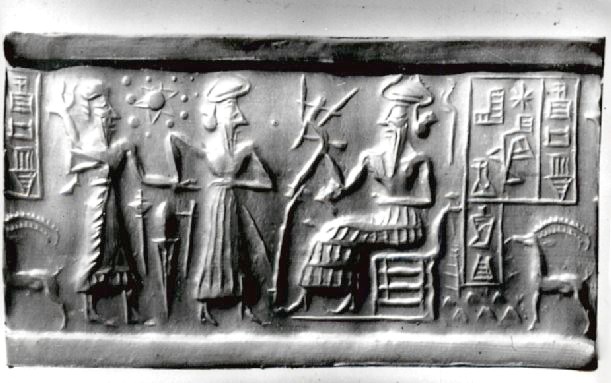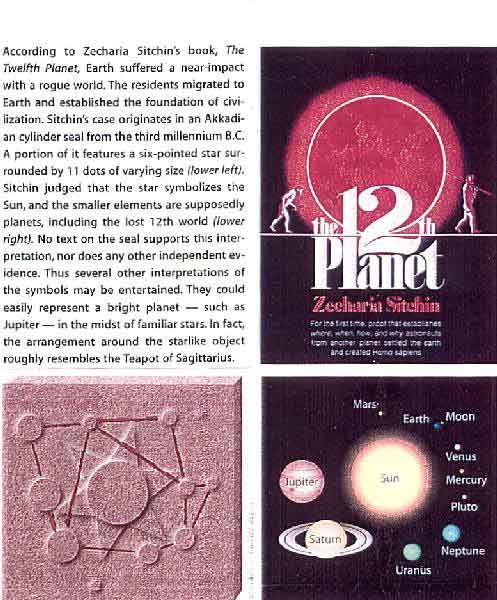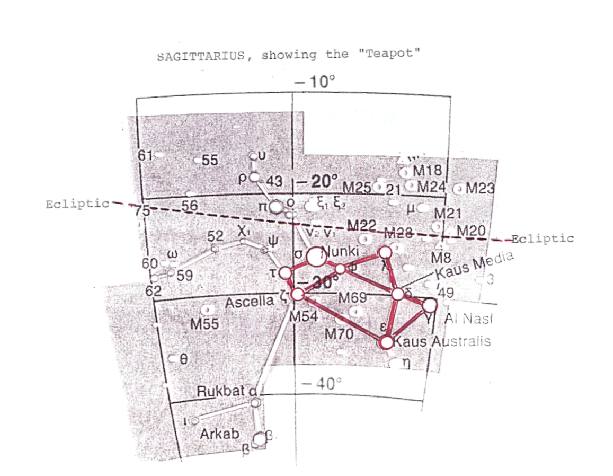The Case of the Misplaced Teapot
A
Failed Challenge To An Enigma of Ancient Astronomy
by Zecharia Sitchin
I was recently pleasantly surprised to encounter an old friend: The colorful cover of the first edition of my first book The 12th Planet (1976), reproduced in the April 2000 issue of Sky & Telescope. The photo was provided by the astronomer E.C. Krupp for his article "Lost Worlds" about misconceived predictions of planetary dooms (such as that regarding 5/5/2000).
Almost a full page is then devoted to "a different astronomical misconception" -- "Zecharia Sitchin's books about ancient space colonists from a lost "12th planet" that once violently invaded our solar system." Conceding (or lamenting?) that “credulous readers are persuaded by Sitchin that the traditions of ancient Sumer validate this unorthodox reconstruction of solar system history," the article suggests in a sidebar (see reproduction) that "Sitchin's case originates in an Akkadian cylinder seal from the third millennium B.C.; a portion of it features a six-pointed star surrounded by eleven dots of varying size; Sitchin judged that the star symbolizes the Sun and the smaller elements are supposedly planets, including the lost 12th world."
The
Embarrassing Ancient Depiction
My inclusion in an article about misconceived predictions of doom (in which I have not engaged -- and this is not the only misrepresentation in the article) was thus an excuse to tackle the embarrassing depiction on cylinder seal VA/243 which I had found in the Vorderasiatisches Museum in (then East) Berlin. On this seal, as on many others, the "mythological scene" is decorated with celestial symbols -- in this case, I have suggested, showing the Sun surrounded by all the planets we know of today, plus the Moon and plus one more planet passing between Mars and Jupiter, the planet named NIBIRU by the Sumerians:

The depiction and my interpretation thereof have embarrassed astronomers for the past quarter of a century, because it is just not possible for ancient peoples to have known about post-Saturn planets, to say nothing about one more yet to be acknowledged "unknown planet." My explanation that the knowledge was provided by the Anunnaki ("Those who from Heaven to Earth came”) -- Extraterrestrial visitors to Earth -- is an even greater anathema to the scientific establishment.
What then to do about cylinder seal VA/243? It exists, it is authentic, it is at least 4,500 years old, If not Sitchin's interpretation -- what?
The
"Teapot" of Sagittarius
So now, a quarter of a century after The 12th Planet was published, the Sky &Telescope article comes to the rescue. The sidebar and its two illustrations offer an alternative. The one on the right purports to show my interpretation of the seal -- colorful, but conveniently omitting the key planet between Mars and Jupiter... The other shows how the "dots" around the central object can be connected to "roughly resemble the Teapot of Sagittarius":
 |
| Sky & Telescope's sidebar, reproducing
the first edition (1976) cover of The 12th Planet and the magazine's two illustrations. |
The solution to the embarrassing enigma of ancient knowledge, as stated in the article's sidebar, is this: The depiction "could easily represent a bright planet -- such as Jupiter -- in the midst of familiar stars; in fact, the arrangement around the star like object roughly resembles the Teapot of Sagittarius."
And so, if the central object is not the Sun but Jupiter (with which the ancients were familiar) and the surrounding objects not planets but the stars of Sagittarius (with which the ancients were familiar)-- Sitchin's extraterrestrials and Nibiru are not needed.
A clever theory -- but based on a misplaced teapot...
A
"Rough Resemblance"?
Sagittarius, one of the twelve zodiacal constellations (a Sumerian first), was named PA.BIL (The Defender) by them and was depicted in antiquity as an Archer, a name and a depiction retained to this day. But some modern astronomers (while having afternoon tea?) decided that the central part of Sagittarius resembles a teapot:
A "spout" formed by connecting the stars Al Nasi, Kaus Media and Kaus Australis (stars gamma, delta and epsilon of the constellation);
A "handle" shaped by the stars designated zeta (Ascella), tau, sigma (Nunki) and phi; and a "lid" indicated by Kaus Borealis (designated lambda).
When these eight stars are connected by imaginary lines, a "teapot" seems to emerge:

Nice Try -- But An Impossible One
One need not be an astronomer to see that the "teapot" imposed upon the ancient depiction (magazine's left illustration) is far from being similar to the actual celestial one;
But one might have to be an astronomer to realize that the offered solution is not only improbable -- it is impossible: Jupiter moves about the Sun in the ecliptic (the plane of planetary orbits around the Sun); it never dips enough in the southern skies to appear in the midst (the magazine's words!) of the Teapot!
The illustration of Sagittarius that shows the "teapot" also indicates the ecliptical path, in which Jupiter moves. AND THE TWAIN CAN NEVER MEET!
Jupiter, once in about twelve years, does scratch the northernmost protrusion of Sagittarius; but it never comes even close (in astronomical terms) to the Teapot, and could have NEVER been observed "in the midst" of the Teapot.
And so, even after a quarter of a century, "Sitchin’s misconception" continues to stand.
Z. SITCHIN
June 2000
Reproduction is permitted if accompanied by the statement
© Z. Sitchin 2000
Reproduced by permission.